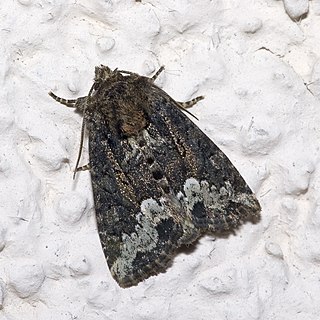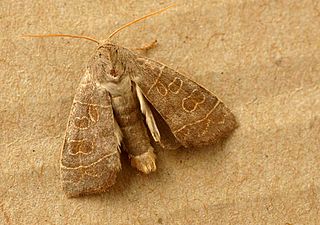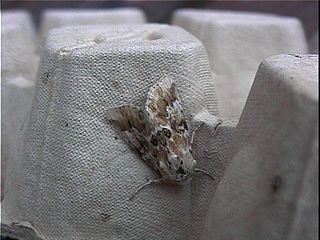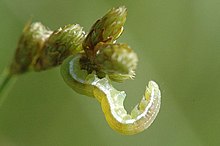
Apamea monoglypha, the dark arches, is a moth of the family Noctuidae. The species was first described by Johann Siegfried Hufnagel in 1766. It is a common, sometimes abundant, European species. It is found in most of Europe except northernmost Fennoscandia and the southern parts of the Iberian Peninsula and Greece. The species is also found in Anatolia, Turkestan, Western Asia and Central Asia, Siberia and Mongolia. In the Alps it is found up to heights of 2,500 meters. The smaller subspecies sardoa is found on Sardinia and Corsica.

Apamea crenata, known as the clouded-bordered brindle, is a moth in the Noctuidae family. It is distributed throughout the Palearctic ecozone.

Apamea remissa, the dusky brocade, is a moth of the family Noctuidae. It is distributed throughout Europe and Turkey, ranging across the Palearctic ecozone to Siberia, Manchuria and Japan. It has also been reported from Alaska.

The marbled minor is a moth of the family Noctuidae. The species was first described by Carl Linnaeus in his 1758 10th edition of Systema Naturae. It is distributed throughout Europe, east through the Palearctic to central Asia and the Altai Mountains. It rises to heights of over 1500 meters in the Alps.

Apamea ophiogramma, the double lobed, is a moth of the family Noctuidae. It is found in the Palearctic ecozone in North and Central Europe to the Urals, Turkestan, Russian Far East, Siberia. There have been at least two separate introductions into North America and it is now rapidly expanding in range. This species is sometimes placed in the monotypic genus Lateroligia.

Ipimorpha subtusa, the olive, is a moth of the family Noctuidae. It is found in the Palearctic ecozone,.

Cryphia raptricula is a species of moth of the family Noctuidae. Over the Palearctic] from the Atlantic Ocean to Central Asia, the Russian Far East including Ussuri and the Altai. Southward reaching the northern parts of the Sahara desert. In Europe, it is primarily found in Central Europe and South-East Europe.

Paradrina clavipalpis, the pale mottled willow, is a moth of the family Noctuidae. The species was first described by Giovanni Antonio Scopoli in his 1763 Entomologia Carniolica. It is found in the Palearctic ecozone. It is an introduced species in North America, where it was first reported from Queens in New York City in 1993. In 2009 it was found in Rochester, New York, so it appears to be established and spreading.

Fissipunctia ypsillon, the dingy shears, is a species of moth of the family Noctuidae. It is found in the Palearctic ecozone

Protodeltote pygarga, the marbled white spot, is a species of moth of the family Noctuidae. It is found in the Palearctic ecozone.

The Bird’s Wing(Dypterygia scabriuscula) is a moth of the family Noctuidae. The species can be found in Europe and the western Palearctic.

The Dusky Sallow is a moth of the family Noctuidae. It is found in Central and Southern Europe and the Middle East.

Synthymia is a genus of moths of the family Noctuidae. It contains only one species, Synthymia fixa, The Goldwing, which is found in southern Europe and North Africa.
Ctenoplusia accentifera is a moth of the family Noctuidae. It is found in South-Western Europe, Greece, Africa, the Near East and Asia Minor.

Grammodes stolida, the geometrician, is a moth of the family Erebidae. The species was first described by Johan Christian Fabricius in 1775. It is found in Africa, southern Europe, most of Asia and Australia. It migrates to central and northern Europe as far north as England, Denmark and Finland.

Nycteola revayana, the oak nycteoline, is a moth of the family Nolidae. The species was first described by Giovanni Antonio Scopoli in 1772. It is found from Europe and east across the Palearctic to Japan and India.

Lithophane furcifera, the conformist, is a moth of the family Noctuidae. The species was first described by Johann Siegfried Hufnagel in 1766. It is found from central Europe, east to the Black Sea region, the Caucasus and western Siberia. In the mountains, it is found up to elevations of 1,800 meters.

Elaphria venustula is a moth of the family Noctuidae. It is found in most of Europe, except the north. In the east, the range extends through the Palearctic to the Pacific Ocean.

The Beautiful Gothic(Leucochlaena oditis) is a Palearctic moth of the family Noctuidae, sub-family Cuculliinae. It is found in southern Europe and north Africa, with occasional finds on the southern coast of England.

Callopistria latreillei, Latreille's Latin, is a moth of the family Noctuidae. The species can be found in the Palaearctic ecozone, most parts of Europe, Asia and in Africa, from Egypt to South Africa. The habitat consists of rocky limestone slopes with deciduous woodland.




















